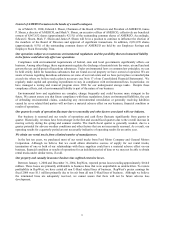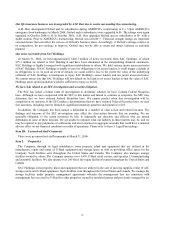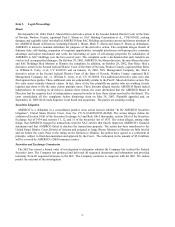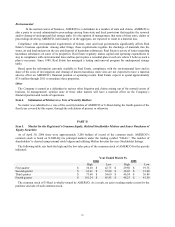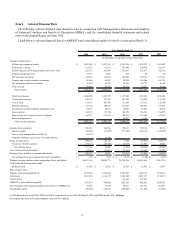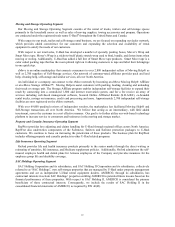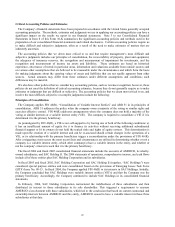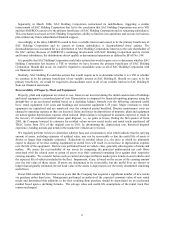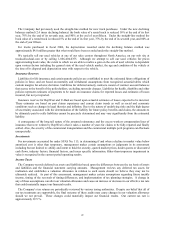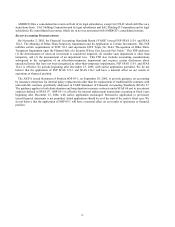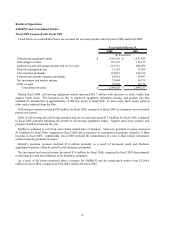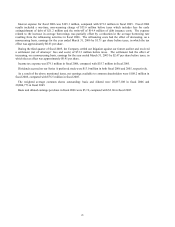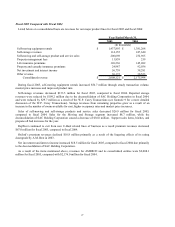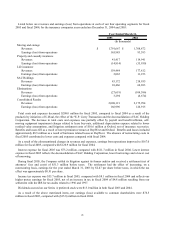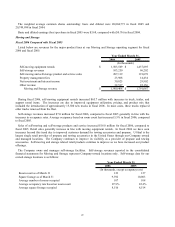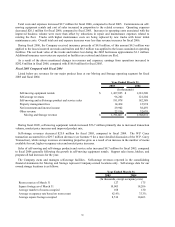U-Haul 2006 Annual Report Download - page 104
Download and view the complete annual report
Please find page 104 of the 2006 U-Haul annual report below. You can navigate through the pages in the report by either clicking on the pages listed below, or by using the keyword search tool below to find specific information within the annual report.Separately, in March 2004, SAC Holding Corporation restructured its indebtedness, triggering a similar
reassessment of SAC Holding Corporation that led to the conclusion that SAC Holding Corporation was not a VIE
and that AMERCO ceased to be the primary beneficiary of SAC Holding Corporation and its remaining subsidiaries.
This conclusion was based on SAC Holding Corporation’ s ability to fund its own operations and execute its business
plan without any future subordinated financial support.
Accordingly, at the dates AMERCO ceased to have a variable interest and ceased to be the primary beneficiary of
SAC Holding Corporation and its current or former subsidiaries, it deconsolidated those entities. The
deconsolidation was accounted for as a distribution of SAC Holding Corporations interests to the sole shareholder of
the SAC entities. Because of AMERCO’ s continuing involvement with SAC Holding Corporation and its current
and former subsidiaries, the distributions do not qualify as discontinued operations as defined by SFAS No. 144.
It is possible that SAC Holding Corporation could take actions that would require us to re-determine whether SAC
Holding Corporation has become a VIE or whether we have become the primary beneficiary of SAC Holding
Corporation. Should this occur, we could be required to consolidate some or all of SAC Holding Corporation with
our financial statements.
Similarly, SAC Holding II could take actions that would require us to re-determine whether it is a VIE or whether
we continue to be the primary beneficiary of our variable interest in SAC Holding II. Should we cease to be the
primary beneficiary, we would be required to deconsolidate some or all of our variable interest in SAC Holding II
from our financial statements.
Recoverability of Property, Plant and Equipment
Property, plant and equipment are stated at cost. Interest cost incurred during the initial construction of buildings
and rental equipment is considered part of cost. Depreciation is computed for financial reporting purposes using the
straight-line or an accelerated method based on a declining balance formula over the following estimated useful
lives: rental equipment 2-20 years and buildings and non-rental equipment 3-55 years. Major overhauls to rental
equipment are capitalized and are amortized over the estimated period benefited. Routine maintenance costs are
charged to operating expense as they are incurred. Gains and losses on dispositions of property, plant and equipment
are netted against depreciation expense when realized. Depreciation is recognized in amounts expected to result in
the recovery of estimated residual values upon disposal, i.e., no gains or losses. During the first quarter of fiscal
2005, the Company lowered its estimates for residual values on new rental trucks and rental trucks purchased off
TRAC leases from 25% of the original cost to 20%. In determining the depreciation rate, historical disposal
experience, holding periods and trends in the market for vehicles are reviewed.
We regularly perform reviews to determine whether facts and circumstances exist which indicate that the carrying
amount of assets, including estimates of residual value, may not be recoverable or that the useful life of assets is
shorter or longer than originally estimated. Reductions in residual values (i.e., the price at which we ultimately
expect to dispose of revenue earning equipment) or useful lives will result in an increase in depreciation expense
over the life of the equipment. Reviews are performed based on vehicle class, generally subcategories of trucks and
trailers. We assess the recoverability of our assets by comparing the projected undiscounted net cash flows
associated with the related asset or group of assets over their estimated remaining lives against their respective
carrying amounts. We consider factors such as current and expected future market price trends on used vehicles and
the expected life of vehicles included in the fleet. Impairment, if any, is based on the excess of the carrying amount
over the fair value of those assets. If assets are determined to be recoverable, but the useful lives are shorter or
longer than originally estimated, the net book value of the assets is depreciated over the newly determined remaining
useful lives.
Fiscal 2006 marked the first time in ten years that the Company has acquired a significant number of new trucks
via purchase rather than lease. Management performed an analysis of the expected economic value of new rental
trucks and determined that additions to the fleet resulting from purchase should be depreciated on an accelerated
method based upon a declining formula. The salvage value and useful life assumptions of the rental truck fleet
remain unchanged.
21


